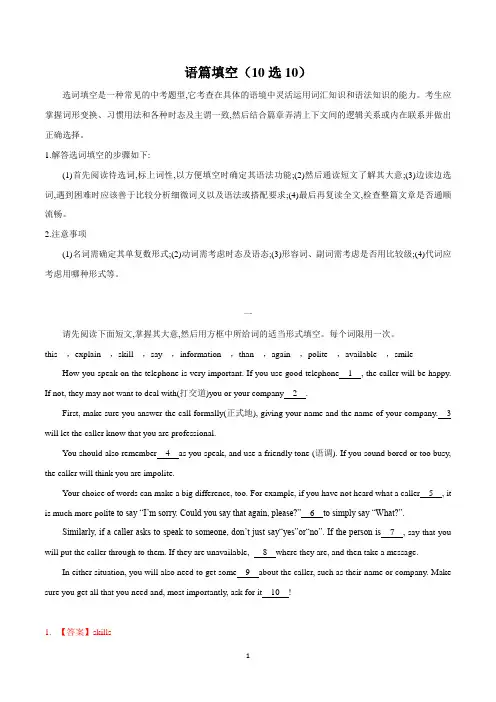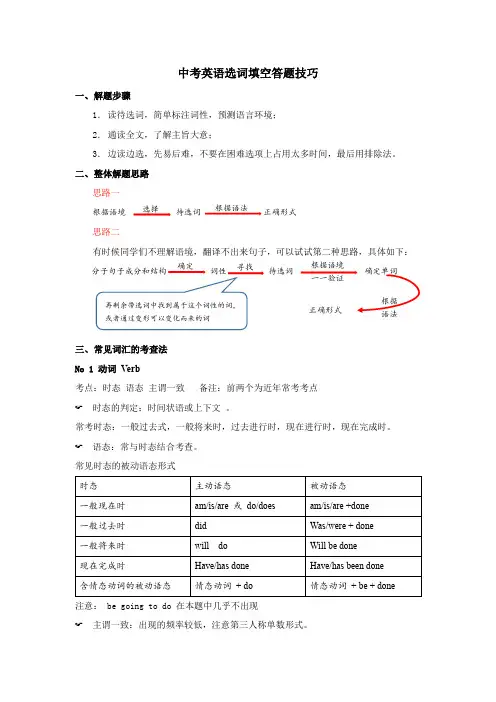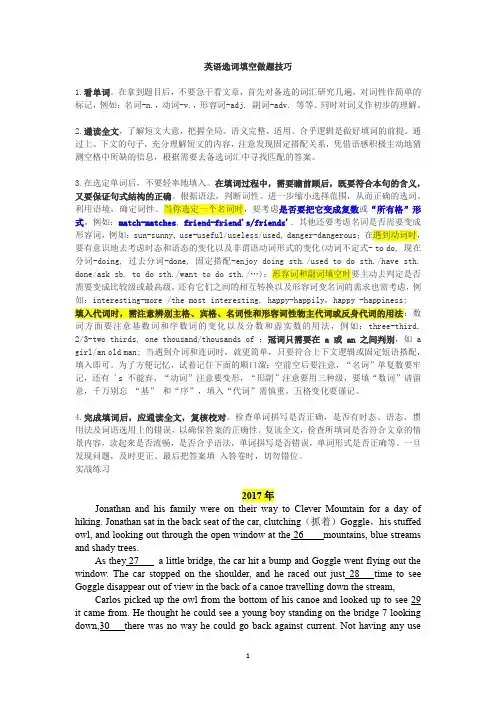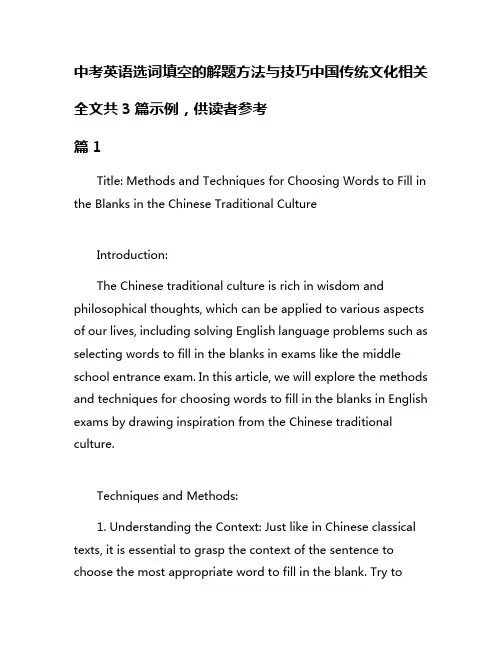中考英语选词填空技巧1
【河南中考英语解题技巧】语篇填空1(10选10)(解析版)

语篇填空(10选10)选词填空是一种常见的中考题型,它考查在具体的语境中灵活运用词汇知识和语法知识的能力。
考生应掌握词形变换、习惯用法和各种时态及主谓一致,然后结合篇章弄清上下文间的逻辑关系或内在联系并做出正确选择。
1.解答选词填空的步骤如下:(1)首先阅读待选词,标上词性,以方便填空时确定其语法功能;(2)然后通读短文了解其大意;(3)边读边选词,遇到困难时应该善于比较分析细微词义以及语法或搭配要求;(4)最后再复读全文,检查整篇文章是否通顺流畅。
2.注意事项(1)名词需确定其单复数形式;(2)动词需考虑时态及语态;(3)形容词、副词需考虑是否用比较级;(4)代词应考虑用哪种形式等。
一请先阅读下面短文,掌握其大意,然后用方框中所给词的适当形式填空。
每个词限用一次。
this,explain,skill,say,information,than,again,polite,available,smile How you speak on the telephone is very important. If you use good telephone1, the caller will be happy. If not, they may not want to deal with(打交道)you or your company2.First, make sure you answer the call formally(正式地), giving your name and the name of your company.3 will let the caller know that you are professional.You should also remember4as you speak, and use a friendly tone (语调). If you sound bored or too busy, the caller will think you are impolite.Your choice of words can make a big difference, too. For example, if you have not heard what a caller5, it is much more pol ite to say “I’m sorry. Could you say that again, please?”6to simply say “What?”.Similarly, if a caller asks to speak to someone, don’t just say“yes”or“no”. If the person is7, say that you will put the caller through to them. If they are unavailable, 8where they are, and then take a message.In either situation, you will also need to get some9about the caller, such as their name or company. Make sure you get all that you need and, most importantly, ask for it10!1.【答案】skills【解析】由下文可知,整篇文章都在讲打电话时的一些技巧。
中考英语选词填空解题技巧

中考英语选词填空答题技巧一、 解题步骤1. 读待选词,简单标注词性,预测语言环境;2. 通读全文,了解主旨大意;3. 边读边选,先易后难,不要在困难选项上占用太多时间,最后用排除法。
二、 整体解题思路思路一根据语境 待选词 正确形式 思路二有时候同学们不理解语境,翻译不出来句子,可以试试第二种思路,具体如下: 分子句子成分和结构 词性 待选词 确定单词三、 常见词汇的考查法No 1 动词 Verb考点:时态 语态 主谓一致 备注:前两个为近年常考考点☞ 时态的判定:时间状语或上下文 。
常考时态:一般过去式,一般将来时,过去进行时,现在进行时,现在完成时。
☞ 语态:常与时态结合考查。
常见时态的被动语态形式时态主动语态 被动语态 一般现在时am/is/are 或 do/does am/is/are +done 一般过去时did Was/were + done 一般将来时will do Will be done 现在完成时Have/has done Have/has been done 含情态动词的被动语态 情态动词 + do 情态动词 + be + done 注意: be going to do 在本题中几乎不出现☞ 主谓一致:出现的频率较低,注意第三人称单数形式。
正确形式 根据 语法 选择 根据语法 寻找再剩余带选词中找到属于这个词性的词,或者通过变形可以变化而来的词根据语境 一一验证确定考点:单复数;变形☞名词单复数:在本题中,选定带选词本身就是名词时,几乎百分百要写成复数形式。
千万记得哦,一定写成复数形式,即使是抽象名词也写成复数形式,例如:culture,experience。
☞变形一动词变名词decide decision argue argument agree agreement exciti excitement express expression☞变形二形容词变名词safe safety happy happiness sad sadnessimportant importanceNo 3 形容词adj考点:变形;比较级;最高级语法知识:形容词修饰名词,作定语。
英语选词填空做题技巧

英语选词填空做题技巧1.看单词。
在拿到题目后,不要急于看文章,首先对备选的词汇研究几遍,对词性作简单的标记,例如:名词-n.,动词-v.,形容词-adj. 副词-adv. 等等。
同时对词义作初步的理解。
2.通读全文,了解短文大意,把握全局。
语义完整、适用、合乎逻辑是做好填词的前提。
通过上、下文的句子,充分理解短文的内容,注意发现固定搭配关系,凭借语感积极主动地猜测空格中所缺的信息,根据需要去备选词汇中寻找匹配的答案。
3.在选定单词后,不要轻率地填入。
在填词过程中,需要瞻前顾后,既要符合本句的含义,又要保证句式结构的正确。
根据语法,判断词性。
进一步缩小选择范围,从而正确的选词。
利用语境,确定词性。
当你选定一个名词时,要考虑是否要把它变成复数或“所有格”形式。
例如:match-matches, friend-friend's/friends'。
其他还要考虑名词是否需要变成形容词,例如:sun-sunny, use-useful/useless/used, danger-dangerous;在遇到动词时,要有意识地去考虑时态和语态的变化以及非谓语动词形式的变化(动词不定式- to do, 现在分词-doing, 过去分词-done, 固定搭配-enjoy doing sth./used to do sth./have sth. done/ask sb. to do sth./want to do sth./…);形容词和副词填空时要主动去判定是否需要变成比较级或最高级,还有它们之间的相互转换以及形容词变名词的需求也需考虑,例如:interesting-more /the most interesting, happy-happily,happy -happiness; 填入代词时,需注意辨别主格、宾格、名词性和形容词性物主代词或反身代词的用法;数词方面要注意基数词和序数词的变化以及分数和虚实数的用法,例如:three-third, 2/3-two thirds, one thousand/thousands of ;冠词只需要在 a或an之间判别,如 a girl/an old man; 当遇到介词和连词时,就更简单,只要符合上下文逻辑或固定短语搭配,填入即可。
中考英语选词填空的解题方法与技巧中国传统文化相关

中考英语选词填空的解题方法与技巧中国传统文化相关全文共3篇示例,供读者参考篇1Title: Methods and Techniques for Choosing Words to Fill in the Blanks in the Chinese Traditional CultureIntroduction:The Chinese traditional culture is rich in wisdom and philosophical thoughts, which can be applied to various aspects of our lives, including solving English language problems such as selecting words to fill in the blanks in exams like the middle school entrance exam. In this article, we will explore the methods and techniques for choosing words to fill in the blanks in English exams by drawing inspiration from the Chinese traditional culture.Techniques and Methods:1. Understanding the Context: Just like in Chinese classical texts, it is essential to grasp the context of the sentence to choose the most appropriate word to fill in the blank. Try tounderstand the overall meaning of the paragraph or passage to ensure that the word you select fits logically and grammatically.2. Use of Analogies: In Chinese literature, analogies are frequently used to create vivid imagery and convey deeper meanings. Similarly, in English language exams, you can use analogies to make educated guesses for choosing the right word to fill in the blank. Think about the relationship between the known words in the sentence and the intended meaning to find a suitable analogy.3. Familiarity with Idioms and Phrases: In both Chinese and English languages, idioms and phrases play a crucial role in conveying specific cultural nuances. By being familiar with idiomatic expressions in English, you can better understand the context of the sentence and choose the most appropriate word to fill in the blank.4. Pay Attention to Word Forms: Chinese characters can have different meanings depending on their form and context, similar to English words. Make sure to pay attention to the tense, part of speech, and grammatical structure of the sentence to choose the correct word form for filling in the blank.5. Utilize Cultural Knowledge: Chinese traditional cultural values such as filial piety, harmony, and respect for elders canprovide insights into the intended meaning of the sentence. By relating these cultural values to the context of the sentence, you can make more informed choices when selecting words to fill in the blanks.Conclusion:In conclusion, by incorporating methods and techniques inspired by the Chinese traditional culture, you can enhance your skills in choosing words to fill in the blanks in English exams. Understanding the context, using analogies, familiarizing yourself with idiomatic expressions, paying attention to word forms, and utilizing cultural knowledge are all valuable strategies that can help you improve your performance in English language assessments. By embracing the wisdom of the Chinese traditional culture, you can navigate through the challenges of selecting words to fill in the blanks with confidence and proficiency.篇2Title: Strategies and Tips for Chinese TraditionalCulture-related Cloze Test in the Middle School English ExamIntroduction:The cloze test is a common type of exercise in the middle school English exam, where students are required to fill in the blanks with appropriate words. In recent years, more and more cloze tests are focusing on Chinese traditional culture-related topics. In this document, we will explore some strategies and tips for successfully completing Chinese traditional culture-related cloze tests.Tips and Strategies:1. Improve Vocabulary:One of the key challenges in cloze tests is filling in the blanks with the correct words. To excel in Chinese traditionalculture-related cloze tests, students need to have a good understanding of Chinese traditional culture vocabulary. It is crucial to enhance vocabulary by reading books, watching documentaries, and attending cultural events.2. Analyze Context:When faced with a blank in a cloze test, students should carefully analyze the context of the whole sentence or paragraph to determine the meaning and suitable word. Understanding the context can provide clues about the type of word needed, such as a verb, noun, adjective, etc.3. Use Grammar Rules:In cloze tests, grammar rules play a vital role in deciding the appropriate word to fill in the blanks. Students should pay attention to grammar structures such as verb forms, prepositions, articles, and tense. By applying grammar rules correctly, students can eliminate incorrect options and select the most suitable word.4. Understand Cultural References:Chinese traditional culture-related cloze tests often contain cultural references, such as historical events, literature, and customs. To answer these questions accurately, students need to have a deep understanding of Chinese traditional culture. Reading Chinese classics, studying historical figures, and exploring ancient traditions can help students comprehend cultural references in cloze tests.5. Practice Regularly:Regular practice is essential for improving performance in cloze tests. Students should solve a variety of cloze test exercises, including Chinese traditional culture-related topics, to familiarize themselves with different question types and enhance theirtest-taking skills. Practicing regularly can also help students build confidence and speed in completing cloze tests.Conclusion:Successfully completing Chinese traditional culture-related cloze tests requires a combination of vocabulary knowledge, context analysis, grammar rules application, cultural understanding, and regular practice. By following the strategies and tips outlined in this document, students can enhance their performance in cloze tests and achieve better results in the middle school English exam. Remember, practice makes perfect, so keep practicing and honing your skills to excel in Chinese traditional culture-related cloze tests.篇3Tips and Techniques for Selecting Words in the Chinese Traditional Culture in the Middle School English ExamIn the middle school English exam, there is always a section where students need to select the correct words to fill in the blanks. This can be a tricky part of the test as it requires not only a good understanding of the language but also a keen sense of logic and context. One effective way to improve your performance in this section is to draw upon the wisdom andrichness of the Chinese traditional culture. Here are some tips and techniques on how to tackle the word selection questions using Chinese traditional cultural knowledge.1. Understand the Context:One of the most important aspects of selecting the correct words in the English exam is to understand the context of the passage. Chinese traditional culture is full of wisdom and stories that can help you interpret the context correctly. For example, when you encounter a passage about perseverance or determination, you can think of the story of "The Foolish Old Man Who Removed the Mountains" from Chinese folklore, which conveys the message that persistence can overcome any obstacle. By understanding the context, you can choose the words that best fit the theme of the passage.2. Use Synonyms and Antonyms:In the word selection questions, you may need to choose words that are synonyms or antonyms of the given words. Chinese traditional culture is rich in proverbs and idioms that can help you identify words with similar or opposite meanings. For example, if you see a word like "brave" in the passage, you can think of the Chinese idiom "勇往直前" (yǒng wǎng zhí qián) whichmeans to proceed courageously and choose a word like "courageous" as the answer.3. Pay Attention to Word Formation:In some cases, you may need to identify the correct form of a word to fill in the blank. Chinese characters have different radicals and components that can help you understand the meaning and form of a word. By analyzing the radicals and components of Chinese characters, you can improve your ability to identify the correct word form in English. For example, if you see a word like "happy" in the passage, you can think of the Chinese character "幸福" (xìngfú) which means happiness and choose a word like "joyful" as the answer.4. Use Cultural References:Chinese traditional culture is full of symbolism and metaphors that can help you identify the correct words in the English exam. For example, when you see a passage about wisdom or intelligence, you can think of the story of Confucius, a great philosopher from ancient China known for his wisdom and teachings. By using cultural references like Confucius, you can better understand the meaning and context of the passage and choose the words that best reflect the theme.5. Practice Regularly:Finally, to improve your performance in the word selection questions, it is important to practice regularly. You can use Chinese traditional cultural stories, proverbs, and idioms as practice materials to enhance your vocabulary and comprehension skills. By practicing regularly, you can develop a better understanding of the language and improve your ability to select the correct words in the English exam.In conclusion, selecting words in the middle school English exam can be challenging, but by using the wisdom and richness of the Chinese traditional culture, you can improve your performance in this section. By understanding the context, using synonyms and antonyms, paying attention to word formation, using cultural references, and practicing regularly, you can become more proficient in selecting the correct words in the English exam. Good luck with your exam preparation!。
河南中考选词填空做题技巧

河南中考选词填空做题技巧1.理解句子结构:首先,需要理解句子的整体结构和意思,这样可以更好地判断需要填入什么类型的词汇。
2.注意时态和语态:根据句子中的时间状语或其他线索,确定正确的时态和语态。
例如,“He ____(发现) that the book he borrowed was missing.”这句话中,因为描述的是过去发生的事情,所以需要用过去时态,即“discovered”。
3.词汇搭配:有些词汇之间有固定的搭配关系,如“感激”与“for your help”,应熟悉这些常见搭配,以便准确填词。
4.上下文理解:通过理解上下文语境,可以推测出正确的词汇。
例如,“She ____(尽力) to do well in the exam.”这句话中,结合上下文可以推断出她在尽力备考,所以答案为“tried her best”。
5.考虑固定搭配和习语:有时答案并不是直接给出的词汇,而是与空格构成固定搭配或习语。
例如,“He ____(忘记) to close the door before leaving the office.”这句话中,“forgot to do”是固定搭配,所以填入“forgot”。
6.检查语法和拼写:完成填空后,务必检查语法是否正确,拼写是否无误。
7.多做练习:通过大量的练习,可以熟悉各种题型和出题方式,提高解题速度和准确性。
8.积累词汇和短语:扩大词汇量,熟悉常用短语和表达方式,有助于更好地完成选词填空题目。
9.注意细节:有时候题目中会有一些陷阱,如细微的语法差异、近义词辨析等,需要仔细审题,避免因疏忽而犯错。
10.学会推理和分析:对于一些需要根据上下文推理和分析的题目,要学会运用逻辑推理和判断力。
综上所述,做选词填空题目需要掌握一定的技巧和策略。
通过练习和实践,不断积累经验和方法,提高语言运用能力和思维逻辑性。
这样在考试中就能够更加自如地应对选词填空等语言运用类题目。
中考英语选词填空满分攻略课件(共25张PPT)

3. 空格处可填的单词不止一个词性,也就是一词多性;
二、四大词性(名、动、形、副)
四大词性(名、动、形、副)
纵观历年真题,我们会发现15个词汇都属于最重要的四类实词:名词(n.);动词(v.);形容词(adj.);副词(adv.)。平时如果熟知每种词汇的基本搭配和用法,答题会轻松许多。
首先进行词性标注和归类如下,对于一词多性的标注具体意思:
三、浏览全文,预测答案
快速扫描文章,预测空格处应填单词的词性。重点来了!选词填空中,该如何判断空格所要求的词性呢?
浏览全文,预测答案
如何预判空格应填名词?
常见空格形态:1. a/an/the + _______2. 冠词 + _______ of ...3. prep. + _______4. adj.+ _______
首句:Contrary to popular belief, older people generally do not want to live with their children. 就点出这段是围绕“老年人其实不想跟他们的孩子住在一起”展开的。
二、标注词性,预先分组
把题目中给出的15个选项,① 按照四大词性进行标注,② 并按词性分组。注意:对于一个词有多个词性的,按多个词性进行分类。还以上面这篇中考题的选项为例:
四大词性(名、动、形、副)
分析历年真题的选项发现:
副词:2~3个,动词:5~7个,(包括屈折变化以三单、-ed和ing结尾的形式和原形)形容词:2~5个;(包括-ed和ing结尾形式的形容词)名词:3~5个。
一般来说,15个选项词性设置规律如下:
选词填空解题方法技巧(初中英语专项复习)2
选词填空解题方法技巧(初中英语专项复习)
1. 跳过空格,速读全文,把握大意
短文填空题的正确答题流程应该为:粗读全文,细读全文并完成每道题目的作笞复读检查。
在粗读阶段,大家应学会无视短文填空题中的空格,直接获取整篇短文的主要信息,以便后续作答环节利用整篇文章的主旨辨别错误选项。
2. 细读全文,瞻前顾后,各个击破
在细读阶段,大家首先应从语法角度直接对题目进行判断。
若无法确定答案,则应联系该空格的前后文,获得该题目的提示信息,逐一完成作答,短文填空题的解答最好按前后顺序完成,当后部题目的解笞面临困扰时,大家可再次精读前文,寻找线索,最终正确作答。
热点话题
短文热衷话题有:社会热点、科技、循环利用、日常生活、健康等。
选词填空是指把一篇文章的关键词语挖空,词序打乱,让学生根据短文内容选择正确的词语填空。
此类题型主要是要求学生在正确理解和把握文章的基础上,通过分析行文线索来填写空缺单词,补全短文。
中考英语试卷中,短文题材非常广泛,可以是科普文、故事、体育甚至文化习俗等、不过、所选的文章,一般都是大家比较熟悉的材料。
选词填空题考查学生对备选词的掌握及对语法的运用能力。
做题时要根据句子结构确定句中所缺词的词性,然后结合句意及备选词即可得出答案。
谈中考英语选词填空解题技巧
谈中考英语选词填空的解题技巧自2008年以来,河南中考英语出现了一种新题型——选词填空。
选词填空也被称为综合填空,它是测试学生对整篇文章的理解能力以及对词汇、语法、习惯用语等的掌握情况的一种形式。
结合多年的教学经验,笔者把平时积累的解题技巧和训练技巧略作归纳,希望能给学生提供一点帮助。
一、中考英语选词填空的特点分析选词填空要求学生利用所给的12个词汇(一般有名词、代词、动词、形容词、副词、数词、冠词、介词、连词等)补全一篇有10个空缺的短文。
其考查的知识面较广,从文化、科学常识到历史地理知识,从风俗民情到民族习惯等,无所不考。
这几年中考命题贴近学生生活实际,试题难度适当,着重考查学生的综合语言运用能力,体现了英语课改的评价理念,遵循了教学规律以及学生综合素质的发展,有利于课程教学改革,全面提高了教育质量,激发了学生的创新精神和实践能力。
二、中考英语选词填空的解题技巧要做好选词填空这一类试题,除了要在七、八年级打好各方面的基础、进行大量的课外阅读、积累丰富的语言知识外,还需掌握一定的解题技巧。
1.观察单词,分析词性先用一两分钟时间将短文的12个候选单词标注词性,这样12个单词就被分成了名词、动词、形容词和副词四个类别,再将这四类单词细化到n.1,n.2,n.3,v.1,v.2,v.3,adj.1,adj.2,adv.1,adv.2等因为这四类词通常是需要根据整篇语境进行适当形式填空的。
如果所确定的词是名词、动词、形容词、副词,应该考虑这些词的相应的形式。
当然,其余不需要变换形式的单词,如介词、连词等也要观察一下它们的特征,比如with和without,although和but,because和so同时出现时,只选其中之一即可,这样就大大降低了选词的难度。
2.快速浏览全文在开始选词填空之前,浏览一下文章,了解一下文章大意是必要的,尤其是要仔细看文章的第一句和各段的首句。
这是因为西方人写文章惯用演绎法,喜欢先把自己要说的意思用一句话概括出来,然后再铺陈论证。
人教版初中英语选词填空解题技巧(最新整理)
初中英语选词填空解题技巧一、对备选的词汇进行研究、对词性作简单的标记,即词性分类。
名词n. 动词v.,形容词adj.副词adv.连词conj.代词pron.数词num冠词art. 介词prep.同时理解词义。
二、通读全文,选词作答1、理解,读懂句子的意思,通读上下文的句子,凭语感猜测空格中所缺的信息,根据需要备选词汇中匹配的答案1)当选定n.时,考虑其单复数形式,名词(单复数)所有格及其adj. teacher2) 当选定v.时, 考虑其时态,语态,非谓语动词形式及固定搭配。
Give3) 当选定adj. adv.时。
考虑原级,比较级,最高级,他们之间的相互转换及adj.转换为n. easy4) 当选定pron.时,考虑其主格,宾格,名词性物主代词,形容词性物主代词和反身代词的用法。
She, he, they5)当选定num.时,注意其基数词和序数词的变化。
one6)当选定art.时,判别a, an,与the7)当选定prep. Conj.时,符合上下文逻辑或固定搭配。
In, but一般常用修饰规则:1)pron. adj. num. art.放在n.之前作定语。
2)adv.放在be动词和实义动词之后做状语。
记住此顺口溜:空前空后要注意,名词单复数要牢记,还有’s不能弃,动词注意要变形,形副注意用三种级,要填数词请注意,千万别忘基和序,填入代词需慎重,五格变化要谨记。
2、完成选词后,诵读全文,复核校对。
1)单词拼写(字母少写,多写,误写)2)动词时态,语态,惯用法,词语选用上的错误3、有答题卡时,填答案时,切勿错位。
“”“”At the end, Xiao Bian gives you a passage. Minand once said, "people who learn to learn are very happy people.". In every wonderful life, learning is an eternal theme. As a professional clerical and teaching position, I understand the importance of continuous learning, "life is diligent, nothing can be gained", only continuous learning can achieve better self. Only by constantly learning and mastering the latest relevant knowledge, can employees from all walks of life keep up with the pace of enterprise development and innovate to meet the needs of the market. This document is also edited by my studio professionals, there may be errors in the document, if there are errors, please correct, thank you!。
中考英语选词填空解题技巧
选词填空解题技巧根据平时的观察,学生在做英语的“选词填空”时,遭遇较多困难,有的甚至条件反射一样畏惧或厌烦。
在此,分享平时积累的解题技巧和训练技巧略,希望能给同学们提供一点帮助。
“选词填空”要求学生利用所给的12个词汇(一般有名词、代词、动词、形容词、副词、数词、冠词、介词和连词等)补全一篇有10个空缺的短文。
要攻克这一难关,学生除了要进1.-n.★match-matches, friend-sun-sunny, use-★(动词不定式- to do, -doing,★★★three-third, 2/3-two thirds, one thousand/thousands of ;★对于冠词,只需要在a或an之间判别,如a girl /an old man;★对于介词和连词时,就更简单,只要符合上下文逻辑或固定短语搭配,填入即可。
为了方便记忆,试着记住下面的顺口溜:空前空后要注意,“名词”单复数要牢记,还有's 不能弃,“动词”注意要变形,“形副”注意要用三种级,要填“数词”请留意,千万别忘“基” 和“序”,填入“代词”需慎重,五格变化要谨记。
4.总结:做题技巧1.统览全局,把握大意。
要填的单词肯定是在一定的语言环境中才能确定。
只有了解了短文的大意,把握了全局才能主导方向,从而有助于正确理解空缺词所在的句子,缩小词的选择范围。
2.根据语法,判定词性。
一般的空缺都可以通过其所在的句式结构和句法成分来判断其词性。
进一步缩小词的选择范围,从而正确地选词。
3.利用语境,确定词形。
当确定了一个单词的词性后可通过上下文来帮助判断其形式。
如动词的人称数、时态、语态、不定式、动词的-ing形式;名词的数和所有格;代词的各种形式及单复数;形容词、副词的比较级以及基数词、序数词的转换形式等。
4.复读全文,验正答案。
填完单词后,不可孤立地逐个检查词,而必须将所有填入的词代入文章中,复读全文,仔细检查所填词是否符合文章的情景内容,读起来是否流畅,是否合乎句法,单词拼写是否有误,单词形式是否正确等。
- 1、下载文档前请自行甄别文档内容的完整性,平台不提供额外的编辑、内容补充、找答案等附加服务。
- 2、"仅部分预览"的文档,不可在线预览部分如存在完整性等问题,可反馈申请退款(可完整预览的文档不适用该条件!)。
- 3、如文档侵犯您的权益,请联系客服反馈,我们会尽快为您处理(人工客服工作时间:9:00-18:30)。
noun (n.)变 verb (v.)
adjective (adj.) adverb (adv.) pronoun (pron.) numeral (num.) preposition (prep.) article (art.) conjunction (conj.) interjection (interj.)
LOGO
解题方法技巧
• 名词“数”要牢记,('s)不能弃; • 代词“五格”心中记,背熟表格上上计; • 数词“基,序”请留意,基序规律要牢记; • 形副“级”莫大意,变化规则须谨记 ; • 动词“形”辩仔细,时态、非谓和被动; • 介词搭配灵活记,介动莫忘ing ; • 冠词连词别遗弃,空前空后看仔细。
In the USA people drink tea at breakfast _o_r__ after meals. They usually use tea bags to make their tea. Making tea with tea bags is faster and __ea_s_i_e_r__ than making it with tea leaves in teapots.
Room3 the third
one/third 分数
数词单位:如hundred, thousand,Million,billion等 有数字,用原形;有of,加s,数字与of不同用。
one-first-once(次数或倍数) two-second-twice
LOGO
名词 动词
形容词 副词 代词 数词 介词 冠词 连词 感叹词
实践应用
LOGO
popular idea or at leaf from drink easy together something
All around the word, people d_r_i_n_k_tea. But tea does not mean the same thing to everyone. In different countries people have very different _id__ea_s__ about drinking tea.
做短文填空试题,考生需要 具备正确拼写所学单词的能力, 具有一定的语法基础知识,掌握 一定的阅读方法,这样做起题才 得心应手。
LOGO
解题方法步骤
综合填空像游戏, 确定成分定词性; 一读文章找大意 , 文章常有中心句; 二读文章猜词意 , 不要得意忘了“形”; 三读文章细检查 , 祝你取得好成绩!
LOGO
序数词 基数词
次数/倍数 分数
词根:数词 num.
LOGO
名词-考点1 (n.)
children child’s
children’s
(复数)
(所有格)
Eric, a 13-year-old c_h_i_ld_ , from Anhui wrote , "I want…. June 1st is __C_h_i_ld_r_e_n_’sDay .
名词性物主代词 宾格
反身代词
形容词性物主代词 主 格
词根:代词 pron.
LOGO
动名词
过去分词
非谓语动词 to+v(原形)
谓语动词
动词原形 动词单三 过去式
过去分词
现在分 词
词根:动词 v.
LOGO
最高级 比较级
反义词
名词 副词
词根:形容词 adj.
LOGO
最高级 比较级
反义词 形容词
词根:副词 adv.
One day a seeing-eye dog and a blind man got __o_n___ a bus together. The bus _w__a_s full of people and there were no seats left. But_o_n_e___ man soon stood up and left his seat. The dog took the blind man to the seat, but there was little _r_o_o_m___ for two people. The dog began to push the people on each side with his nose. He pushed and pushed _u__n_ti_l_ the people moved and at last there was _en__o_u_g_h space for two people. The blind man then _s_a_t __ down and the dog got up on the seat at his side. The dog jumped down and put his head on the leg of the blind man. He was very comfortable and soon fell__a_s_le_e_p_. Everyone on the bus smiled at the dog.
Tea is also important in Japan. It is very _p_o_p_u_l_a_r there. People drink tea every day. But they have it in a way different _f_r_o_m___ that in China.
LOGO
解题五步曲
1.确定词性 --- 2.寻找大意 --- 3.猜测词意
-- 4.不要忘“形” -- 5.仔细检查
LOGO
词形变化
LOGO
你还记得吗?
1.please-_p_l_e_a_s_e_d -_p_l_e_a_s_a_nt -__p_le__a_s_u_re
4.health- healthy
most careful (最高级)
carefully (adv.)
care (n. /v.)
more carefully (比较级)
most carefully (最高级)
反义词:un-
dis-
im/in-
-less
-ful
LOGO
代词-考点5
物主代词
人称代词
we us (pron.)
(主格) (宾格)
主,宾,形后
动词-考点2
LOGO
teach
(v.)
teaches taug) (现在分词)
(过去分词)
teacher
(名词)
(形容词)
被动语态:be + Vp.p
LOGO
careless (反义词)
careful (adj.)
形容词、副词-考点 3/4
more careful (比较级)
• 它是在一篇语意完整的短文中有目的地制 造一些空格(障碍物),造成信息链(语 义)的中断,让考生在理解短文的基础上, 综合运用所学知识和常识,对每个题的备 选项作出合理的分析、判断,选出最佳答 案,将空格处缺失的信息补充完整,使重 新构建的文章主旨鲜明,逻辑严密,文意 通畅。
LOGO
LOGO
In China people always have tea t_o_g_e_t_h_e_r_ with their friends. They may drink tea _a_t_any time of the day. They only put tea _le_a_v_e_s__ in their cups. They prefer the tea with _n_o_t_h_in_g__else in it.
LOGO
1. in 、on、 for、 to … 2. and、 so、 but 、 then … 3. oh 、 hello … 4. a 、 an、 the
介词(prep) 连词(conj.) 感叹词(interj.)
冠词 (art.)
注:
这些词变化简单,按照文章前后的逻辑意思,搭配填入即可。
LOGO
playing be played
played
play
player
plays
playful (爱玩耍的)
LOGO
our
ours we us
ourselves
LOGO
women
woman woman’s
women’s
LOGO
happily
the happiest
happy happier
- _t_h_e_i_r_ (adj性物主代词 t_h__e_ir_s_ (n.性物主代词)
a-_c_t_iv_i_t_i_e_s_(复数)
- th_e_m__s_e_l_v_e_s (反身代词
LOGO
形容词 比较级 最高级
副词
不可数
名词所有格
名词’ s
可数
名词s’ 单数
复数
词根:词性 n.
LOGO
-_u_n_lu_c__k_y_ (adj的反义词
(adj)
-_k_n__e_w
)
-k__n_o_w_n_
(过去式 (过去分词
)
) 6.they-
-u_n_l_u_c_k_i_ly_ (adv的反义词
_t_h_e_m__
(宾格)
3.activity-___a_c_t__ (v.) -_a_c_t_i_v_e_ (adj)
unhappy
happiness (幸福 n.)
LOGO
interesting
interest interests
interested
LOGO
实战演练
LOGO
